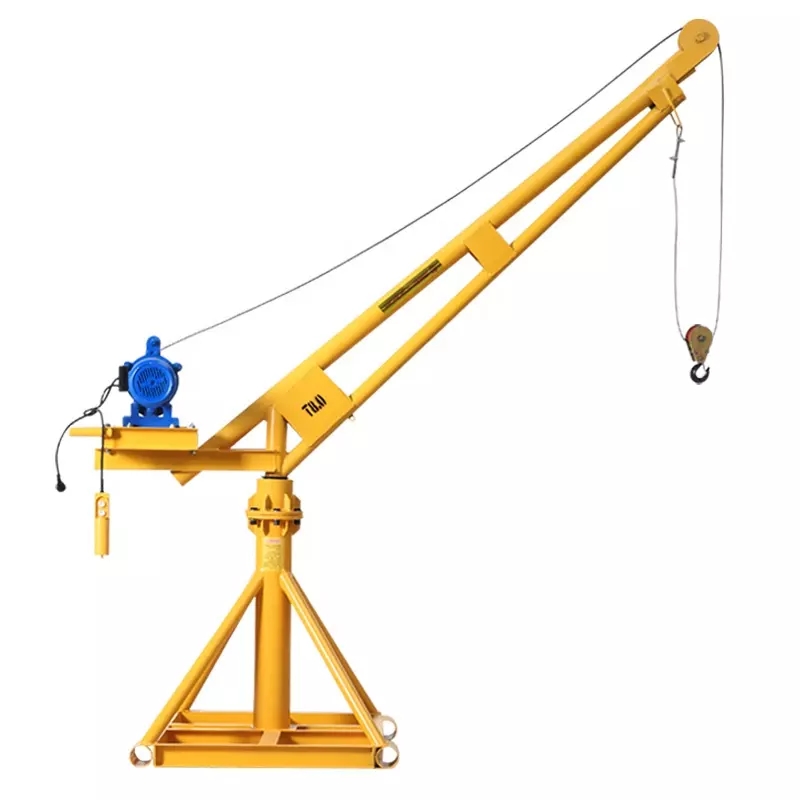The environmental implications of using small portable crane lifts can vary depending on factors such as the type of fuel or power source used, the frequency and duration of operation, and the specific environmental conditions of the project site.
Here are some potential environmental considerations associated with the use of small portable crane lifts:
- Emissions: Small portable crane lifts powered by internal combustion engines, such as diesel or gasoline, can emit pollutants such as carbon monoxide (CO), nitrogen oxides (NOx), particulate matter (PM), and hydrocarbons (HC). These emissions contribute to air pollution and can have adverse effects on air quality, human health, and the environment, especially in urban or sensitive ecosystems.
- Fuel Consumption: The fuel consumption of small portable crane lifts can contribute to the consumption of finite fossil fuel resources and greenhouse gas emissions, particularly if they are operated intensively over extended periods. Minimizing fuel consumption through efficient engine design, proper maintenance, and optimized operating practices can help reduce environmental impacts.
- Noise Pollution: Small portable crane lifts can generate noise pollution during operation, which can disturb nearby residents, wildlife, and sensitive ecosystems. Noise levels can vary depending on factors such as the type of crane, the power source, and the proximity of the project site to residential or sensitive areas. Implementing noise mitigation measures, such as using quieter equipment, scheduling operations during less sensitive times, or erecting sound barriers, can help minimize noise impacts.
- Habitat Disturbance: The deployment of small portable crane lifts in natural or ecologically sensitive areas can disturb wildlife habitats, disrupt ecosystems, and cause soil erosion or vegetation damage. Proper site selection, habitat assessment, and mitigation measures can help minimize habitat disturbance and protect sensitive environments.
- Waste Generation: Maintenance, repair, and disposal of small portable crane lifts can generate waste materials such as used lubricants, filters, batteries, and other consumables. Proper waste management practices, including recycling, reuse, or safe disposal of waste materials, are essential for minimizing environmental impacts and complying with regulations.
- Land Use: The operation of small portable crane lifts may require temporary occupation of land or disruption of natural landscapes, particularly during construction or maintenance activities. Minimizing land use impacts through efficient project planning, site layout optimization, and restoration of disturbed areas after project completion can help mitigate environmental impacts.
- Spill Prevention: Small portable crane lifts that use hydraulic fluids, lubricants, or other hazardous substances pose a risk of accidental spills or leaks, which can contaminate soil, water bodies, or groundwater. Implementing spill prevention measures, such as proper handling, storage, and containment of hazardous materials, as well as emergency response procedures, is critical for minimizing environmental risks.
By considering these environmental implications and implementing appropriate mitigation measures, the use of small portable crane lifts can be managed in a manner that minimizes adverse impacts on the environment while supporting construction, maintenance, and other industrial activities.
How do portable cranes for lifting handle storage and maintenance when not in use?
When portable cranes for lifting are not in use, proper storage and maintenance practices are essential to ensure their longevity, performance, and safety.
Here’s how portable cranes are typically handled during periods of non-use:
- Cleaning: Before storage, portable cranes should be thoroughly cleaned to remove dirt, debris, and contaminants that could cause corrosion or damage to components. This includes washing the crane structure, inspecting hydraulic hoses and fittings, and removing any accumulated grease or grime.
- Inspecting for Damage: A comprehensive inspection should be conducted to identify any signs of damage, wear, or deterioration that may have occurred during operation. This includes checking for cracks, corrosion, loose fasteners, hydraulic leaks, and worn-out components. Any identified issues should be addressed promptly to prevent further damage.
- Lubrication: Proper lubrication of moving parts is essential for maintaining the performance and longevity of portable cranes. Lubricants should be applied to bearings, gears, chains, cables, and other critical components according to manufacturer recommendations. This helps reduce friction, prevent wear, and ensure smooth operation when the crane is put back into service.
- Storage Location: Portable cranes should be stored in a clean, dry, and well-ventilated location to protect them from environmental factors such as moisture, humidity, and temperature fluctuations. Ideally, cranes should be stored indoors or under cover to shield them from rain, snow, and sunlight, which can accelerate corrosion and deterioration of materials.
- Proper Positioning: When not in use, portable cranes should be positioned on stable and level ground to prevent instability or tipping. Stabilizers or outriggers should be deployed if necessary to ensure the crane remains stable during storage. Additionally, the crane’s boom and jib should be properly stowed and secured to prevent damage or accidents.
- Battery Maintenance: If the portable crane is battery-powered, proper battery maintenance is essential to ensure optimal performance and lifespan. Batteries should be fully charged before storage and periodically checked to prevent discharge or sulfation. Battery terminals should be cleaned and corrosion-free, and batteries should be stored in a cool, dry location away from direct sunlight.
- Documentation and Record-Keeping: Maintaining accurate records of maintenance activities, inspections, and repairs is crucial for tracking the condition and history of the portable crane. This information can help identify trends, anticipate maintenance needs, and ensure compliance with regulatory requirements.
- Periodic Inspection: Even when not in use, portable cranes should undergo periodic inspections to verify their condition and readiness for operation. This includes checking critical components, verifying proper functionality of safety devices, and conducting preventive maintenance tasks as needed.
By following these storage and maintenance practices, portable cranes for lifting can be kept in optimal condition during periods of non-use, ensuring they are ready for safe and reliable operation when needed.
